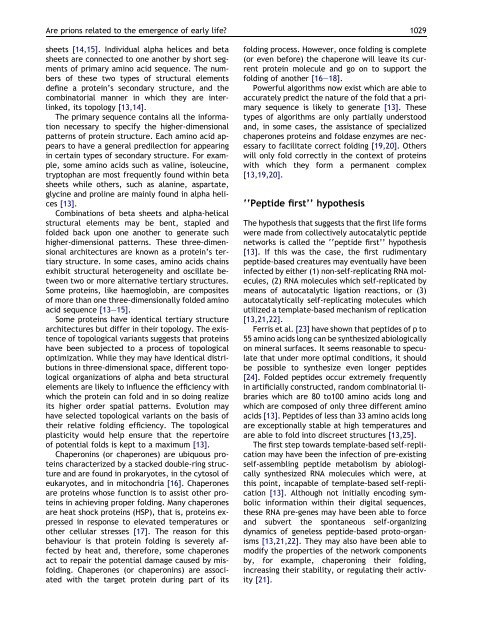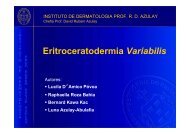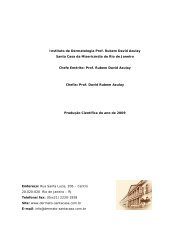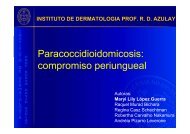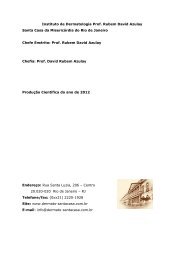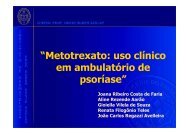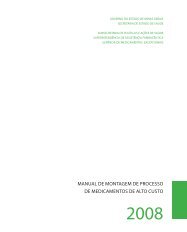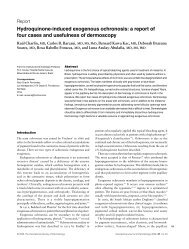Are prions related to the emergence of early life? - instituto de ...
Are prions related to the emergence of early life? - instituto de ...
Are prions related to the emergence of early life? - instituto de ...
You also want an ePaper? Increase the reach of your titles
YUMPU automatically turns print PDFs into web optimized ePapers that Google loves.
<strong>Are</strong> <strong>prions</strong> <strong>related</strong> <strong>to</strong> <strong>the</strong> <strong>emergence</strong> <strong>of</strong> <strong>early</strong> <strong>life</strong>? 1029<br />
sheets [14,15]. Individual alpha helices and beta<br />
sheets are connected <strong>to</strong> one ano<strong>the</strong>r by short segments<br />
<strong>of</strong> primary amino acid sequence. The numbers<br />
<strong>of</strong> <strong>the</strong>se two types <strong>of</strong> structural elements<br />
<strong>de</strong>fine a protein’s secondary structure, and <strong>the</strong><br />
combina<strong>to</strong>rial manner in which <strong>the</strong>y are interlinked,<br />
its <strong>to</strong>pology [13,14].<br />
The primary sequence contains all <strong>the</strong> information<br />
necessary <strong>to</strong> specify <strong>the</strong> higher-dimensional<br />
patterns <strong>of</strong> protein structure. Each amino acid appears<br />
<strong>to</strong> have a general predilection for appearing<br />
in certain types <strong>of</strong> secondary structure. For example,<br />
some amino acids such as valine, isoleucine,<br />
tryp<strong>to</strong>phan are most frequently found within beta<br />
sheets while o<strong>the</strong>rs, such as alanine, aspartate,<br />
glycine and proline are mainly found in alpha helices<br />
[13].<br />
Combinations <strong>of</strong> beta sheets and alpha-helical<br />
structural elements may be bent, stapled and<br />
fol<strong>de</strong>d back upon one ano<strong>the</strong>r <strong>to</strong> generate such<br />
higher-dimensional patterns. These three-dimensional<br />
architectures are known as a protein’s tertiary<br />
structure. In some cases, amino acids chains<br />
exhibit structural heterogeneity and oscillate between<br />
two or more alternative tertiary structures.<br />
Some proteins, like haemoglobin, are composites<br />
<strong>of</strong> more than one three-dimensionally fol<strong>de</strong>d amino<br />
acid sequence [13–15].<br />
Some proteins have i<strong>de</strong>ntical tertiary structure<br />
architectures but differ in <strong>the</strong>ir <strong>to</strong>pology. The existence<br />
<strong>of</strong> <strong>to</strong>pological variants suggests that proteins<br />
have been subjected <strong>to</strong> a process <strong>of</strong> <strong>to</strong>pological<br />
optimization. While <strong>the</strong>y may have i<strong>de</strong>ntical distributions<br />
in three-dimensional space, different <strong>to</strong>pological<br />
organizations <strong>of</strong> alpha and beta structural<br />
elements are likely <strong>to</strong> influence <strong>the</strong> efficiency with<br />
which <strong>the</strong> protein can fold and in so doing realize<br />
its higher or<strong>de</strong>r spatial patterns. Evolution may<br />
have selected <strong>to</strong>pological variants on <strong>the</strong> basis <strong>of</strong><br />
<strong>the</strong>ir relative folding efficiency. The <strong>to</strong>pological<br />
plasticity would help ensure that <strong>the</strong> reper<strong>to</strong>ire<br />
<strong>of</strong> potential folds is kept <strong>to</strong> a maximum [13].<br />
Chaperonins (or chaperones) are ubiquous proteins<br />
characterized by a stacked double-ring structure<br />
and are found in prokaryotes, in <strong>the</strong> cy<strong>to</strong>sol <strong>of</strong><br />
eukaryotes, and in mi<strong>to</strong>chondria [16]. Chaperones<br />
are proteins whose function is <strong>to</strong> assist o<strong>the</strong>r proteins<br />
in achieving proper folding. Many chaperones<br />
are heat shock proteins (HSP), that is, proteins expressed<br />
in response <strong>to</strong> elevated temperatures or<br />
o<strong>the</strong>r cellular stresses [17]. The reason for this<br />
behaviour is that protein folding is severely affected<br />
by heat and, <strong>the</strong>refore, some chaperones<br />
act <strong>to</strong> repair <strong>the</strong> potential damage caused by misfolding.<br />
Chaperones (or chaperonins) are associated<br />
with <strong>the</strong> target protein during part <strong>of</strong> its<br />
folding process. However, once folding is complete<br />
(or even before) <strong>the</strong> chaperone will leave its current<br />
protein molecule and go on <strong>to</strong> support <strong>the</strong><br />
folding <strong>of</strong> ano<strong>the</strong>r [16–18].<br />
Powerful algorithms now exist which are able <strong>to</strong><br />
accurately predict <strong>the</strong> nature <strong>of</strong> <strong>the</strong> fold that a primary<br />
sequence is likely <strong>to</strong> generate [13]. These<br />
types <strong>of</strong> algorithms are only partially un<strong>de</strong>rs<strong>to</strong>od<br />
and, in some cases, <strong>the</strong> assistance <strong>of</strong> specialized<br />
chaperones proteins and foldase enzymes are necessary<br />
<strong>to</strong> facilitate correct folding [19,20]. O<strong>the</strong>rs<br />
will only fold correctly in <strong>the</strong> context <strong>of</strong> proteins<br />
with which <strong>the</strong>y form a permanent complex<br />
[13,19,20].<br />
‘‘Pepti<strong>de</strong> first’’ hypo<strong>the</strong>sis<br />
The hypo<strong>the</strong>sis that suggests that <strong>the</strong> first <strong>life</strong> forms<br />
were ma<strong>de</strong> from collectively au<strong>to</strong>catalytic pepti<strong>de</strong><br />
networks is called <strong>the</strong> ‘‘pepti<strong>de</strong> first’’ hypo<strong>the</strong>sis<br />
[13]. If this was <strong>the</strong> case, <strong>the</strong> first rudimentary<br />
pepti<strong>de</strong>-based creatures may eventually have been<br />
infected by ei<strong>the</strong>r (1) non-self-replicating RNA molecules,<br />
(2) RNA molecules which self-replicated by<br />
means <strong>of</strong> au<strong>to</strong>catalytic ligation reactions, or (3)<br />
au<strong>to</strong>catalytically self-replicating molecules which<br />
utilized a template-based mechanism <strong>of</strong> replication<br />
[13,21,22].<br />
Ferris et al. [23] have shown that pepti<strong>de</strong>s <strong>of</strong> p <strong>to</strong><br />
55 amino acids long can be syn<strong>the</strong>sized abiologically<br />
on mineral surfaces. It seems reasonable <strong>to</strong> speculate<br />
that un<strong>de</strong>r more optimal conditions, it should<br />
be possible <strong>to</strong> syn<strong>the</strong>size even longer pepti<strong>de</strong>s<br />
[24]. Fol<strong>de</strong>d pepti<strong>de</strong>s occur extremely frequently<br />
in artificially constructed, random combina<strong>to</strong>rial libraries<br />
which are 80 <strong>to</strong>100 amino acids long and<br />
which are composed <strong>of</strong> only three different amino<br />
acids [13]. Pepti<strong>de</strong>s <strong>of</strong> less than 33 amino acids long<br />
are exceptionally stable at high temperatures and<br />
are able <strong>to</strong> fold in<strong>to</strong> discreet structures [13,25].<br />
The first step <strong>to</strong>wards template-based self-replication<br />
may have been <strong>the</strong> infection <strong>of</strong> pre-existing<br />
self-assembling pepti<strong>de</strong> metabolism by abiologically<br />
syn<strong>the</strong>sized RNA molecules which were, at<br />
this point, incapable <strong>of</strong> template-based self-replication<br />
[13]. Although not initially encoding symbolic<br />
information within <strong>the</strong>ir digital sequences,<br />
<strong>the</strong>se RNA pre-genes may have been able <strong>to</strong> force<br />
and subvert <strong>the</strong> spontaneous self-organizing<br />
dynamics <strong>of</strong> geneless pepti<strong>de</strong>-based pro<strong>to</strong>-organisms<br />
[13,21,22]. They may also have been able <strong>to</strong><br />
modify <strong>the</strong> properties <strong>of</strong> <strong>the</strong> network components<br />
by, for example, chaperoning <strong>the</strong>ir folding,<br />
increasing <strong>the</strong>ir stability, or regulating <strong>the</strong>ir activity<br />
[21].


